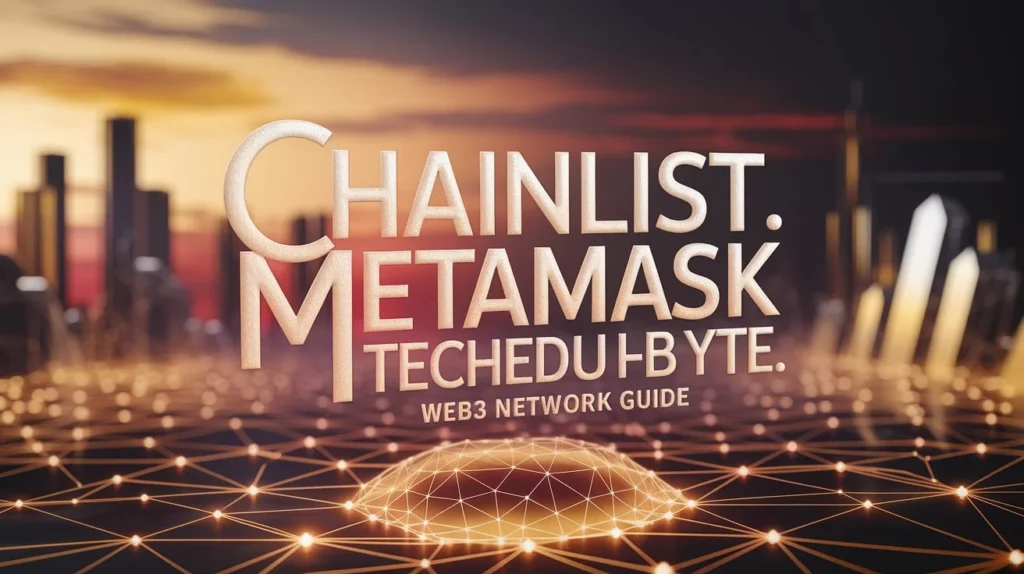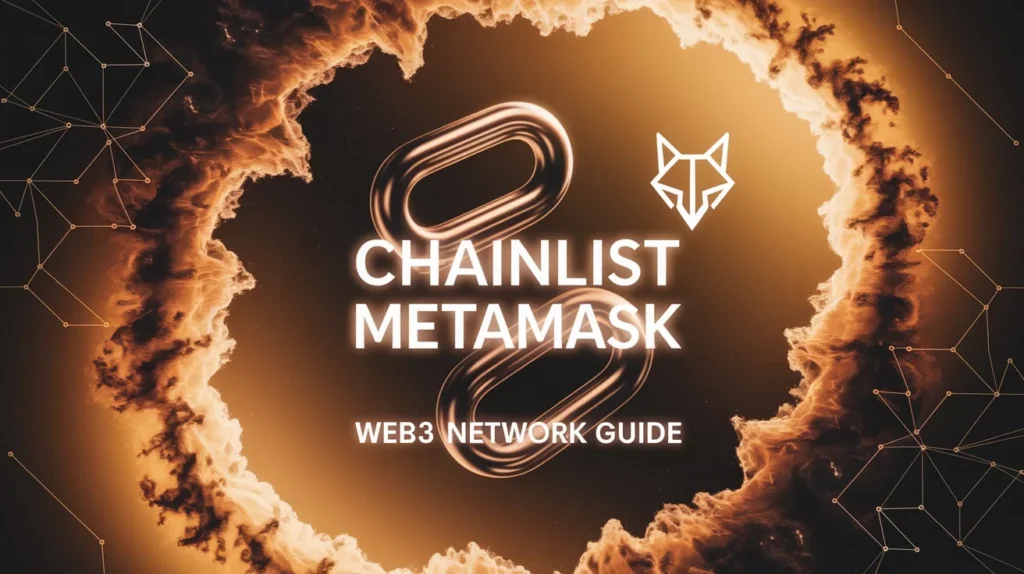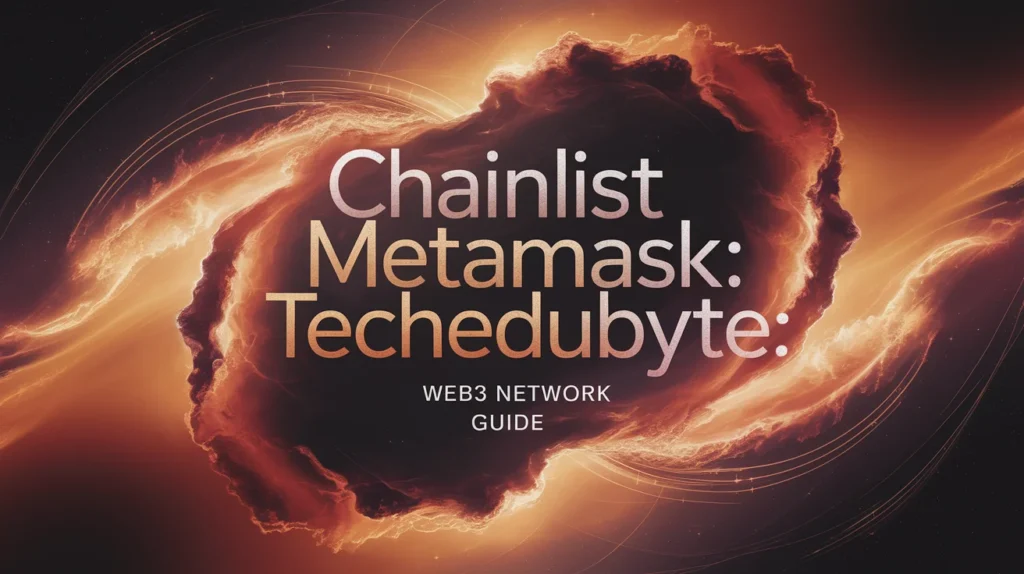Chainlist has emerged as a game-changing tool in the rapidly evolving Web3 ecosystem, simplifying the way users connect and manage blockchain networks within their crypto wallets. By seamlessly integrating with MetaMask, Chainlist enables both novice and advanced users to add, configure, and switch between multiple networks, including Ethereum, Layer 2 solutions, and other popular chains, without the need for manual RPC configurations. This integration is crucial for users participating in decentralized finance (DeFi), interacting with smart contracts, and exploring the expansive world of Web3.
MetaMask is one of the most popular crypto wallets, providing secure storage for cryptocurrencies and tokens while serving as a gateway to dApps. Chainlist enhances this experience by offering a curated list of blockchain networks with verified RPC URLs, chain IDs, and network explorers, ensuring both safety and convenience. Leveraging insights from Techedubyte, this guide delves deep into the functionalities, benefits, and future of Chainlist in Web3 network management.
This comprehensive article covers everything from network addition steps, security best practices, advanced developer features, integration with DeFi protocols, troubleshooting common issues, and predicting future trends in decentralized network management. By the end, readers will gain a strong understanding of how to efficiently utilize Chainlist and MetaMask to navigate the decentralized world with confidence.
What is Chainlist?
Chainlist is an online platform that aggregates blockchain networks and provides a verified list of their configuration details for easy integration with cryptocurrency wallets, such as MetaMask. It acts as a bridge between users and the vast ecosystem of blockchain networks, eliminating the technical barrier of manual configuration. Users can discover networks such as Ethereum mainnet, Binance Smart Chain, Polygon, Avalanche, and various Layer 2 solutions, each with verified RPC endpoints, chain IDs, and explorers.
Chainlist is particularly relevant for Web3 participants who frequently interact with decentralized applications (dApps), DeFi protocols, and smart contracts. By streamlining network management, it reduces the risk of errors that can occur when manually entering network details, ensuring smoother transactions and reliable connectivity.
Key Features
- Verified network RPC URLs and chain IDs
- Easy integration with MetaMask and other compatible wallets
- Curated list of mainnets and testnets
- Support for Layer 2 solutions and alternative blockchain networks
- Safety mechanisms to prevent malicious network configurations
How Chainlist Works With MetaMask

MetaMask is a popular crypto wallet that allows users to manage their digital assets and interact with decentralized applications (dApps). By integrating Chainlist with MetaMask, users can easily add new blockchain networks without having to enter complex configurations manually. This integration streamlines the process of connecting to various blockchain networks, enhancing the overall user experience.
To add a network to MetaMask using Chainlist:
- Visit the Chainlist website.
- Connect your MetaMask wallet by clicking on the “Connect Wallet” button.
- Use the search bar to find the network you wish to add.
- Click on the “Add to MetaMask” button next to the desired network.
- Confirm the network details in the MetaMask pop-up and approve the addition.
This seamless process eliminates the need for manual entry of network details, reducing the risk of errors and enhancing security.
Example
Adding the Polygon network via Chainlist:
- Network Name: Polygon Mainnet
- Chain ID: 137
- RPC URL: https://polygon-rpc.com
- Symbol: MATIC
- Explorer URL: https://polygonscan.com
Upon clicking “Add to MetaMask,” these details are automatically populated and saved.
Step-by-Step Guide to Adding Networks via Chainlist
Adding networks using Chainlist is straightforward. Follow these steps:
- Open Chainlist.org in your browser.
- Connect your MetaMask wallet by clicking “Connect Wallet.”
- Use the search bar to locate the network you wish to add.
- Click on the network card and press “Add to MetaMask.”
- Approve the connection in MetaMask.
- Switch to the new network from the MetaMask interface.
Tips for Smooth Configuration
- Ensure MetaMask is updated to the latest version.
- Verify the network using Chainlist’s verified badge.
- Double-check network details before adding testnets.
- Utilize Layer 2 networks for faster and more cost-effective transactions.
Benefits of Using Chainlist

Using Chainlist offers numerous advantages for both new and experienced crypto users. One of the key benefits is the ease of network configuration; users can add multiple blockchain networks to MetaMask with a single click, eliminating the need to manually enter complex details like RPC URLs, Chain IDs, and currency symbols. This not only saves time but also reduces the risk of errors that could compromise transactions.
Chainlist also provides verified and up-to-date network information, ensuring that users connect to legitimate networks, which is particularly important in the rapidly evolving Web3 ecosystem. Additionally, the platform supports a wide variety of networks, including Ethereum mainnet, Binance Smart Chain, Polygon, and numerous Layer 2 solutions, offering flexibility for interacting with DeFi applications, smart contracts, and other decentralized services.
For developers, Chainlist’s open-source nature allows for custom network additions and testing environments, facilitating smart contract development and multi-chain integration. Overall, Chainlist enhances both the security and efficiency of managing crypto wallets, making it an indispensable tool for anyone engaged in blockchain activities.
Popular Networks Supported
Chainlist supports a wide range of blockchain networks, including:
| Network Name | Chain ID | RPC URL | Symbol | Explorer URL |
| Ethereum Mainnet | 1 | https://mainnet.infura.io/v3/YOUR-PROJECT-ID | ETH | https://etherscan.io |
| Binance Smart Chain | 56 | https://bsc-dataseed.binance.org/ | BNB | https://bscscan.com |
| Polygon | 137 | https://polygon-rpc.com | MATIC | https://polygonscan.com |
| Avalanche | 43114 | https://api.avax.network/ext/bc/C/rpc | AVAX | https://snowtrace.io |
| Arbitrum | 42161 | https://arb1.arbitrum.io/rpc | ETH | https://arbiscan.io |
This table can be expanded as new networks are added or verified on Chainlist.
Security Considerations and Best Practices
While Chainlist simplifies network management, users should remain vigilant.
Best Practices
- Only add networks from verified sources.
- Avoid sharing private keys.
- Regularly update MetaMask.
- Use hardware wallets for high-value transactions.
- Check for network warnings on Chainlist.
Security is crucial, especially when interacting with smart contracts and DeFi platforms. Chainlist’s verification system reduces the likelihood of connecting to malicious networks.
Advanced Features for Developers
Chainlist offers features beyond basic network addition:
- Testnet Integration: For developers testing dApps and smart contracts.
- Layer 2 Networks: Integration with Optimism, Arbitrum, and Polygon for cost-effective transactions.
- Custom RPC Addition: Developers can add private networks for internal testing.
- API Access: Enables automation of network management and monitoring.
These features facilitate faster development cycles and easier deployment of decentralized applications.
Integration with DeFi and dApps
Chainlist enhances DeFi and dApp usability by ensuring correct network configuration. Popular DeFi protocols like Uniswap, Aave, and Compound require specific networks. Misconfigured wallets can lead to failed transactions or loss of funds.
Examples
- Connecting to Polygon to reduce Ethereum gas fees on Uniswap.
- Accessing Avalanche-based lending platforms for faster transaction times.
- Switching networks seamlessly in MetaMask to interact with Layer 2 dApps.
Proper network configuration via Chainlist ensures a smooth experience across multiple platforms.
Troubleshooting Common Issues
Even with Chainlist, users may encounter issues:
Common Problems
- Network Not Appearing: Ensure MetaMask is unlocked and connected.
- RPC Errors: Check Chainlist for updated RPC URLs.
- Token Balance Not Showing: Add the token manually using its contract address.
- Slow Transactions: Switch to a different RPC node for improved speed.
Tips
- Clear browser cache.
- Update MetaMask.
- Verify network parameters on Chainlist before adding.
Future of Chainlist and Web3 Network Management
The future of Chainlist is closely tied to the evolution of Web3:
- Expansion of Supported Networks: Integration of emerging Layer 2 and sidechains.
- Enhanced Security Measures: AI-driven verification of network parameters.
- Developer Tools: Advanced APIs and SDKs for dApp integration.
- Seamless Cross-Chain Connectivity: Enabling multi-chain transactions with fewer friction points.
Web3 network management will become more user-friendly, secure, and efficient, making tools like Chainlist indispensable.
Conclusion
Chainlist, in conjunction with MetaMask, has revolutionized the way users navigate the Web3 ecosystem. By simplifying network addition, ensuring security, and supporting a wide range of blockchain networks, it empowers both casual users and developers to fully leverage the benefits of decentralized finance, smart contracts, and Layer 2 solutions. Insights from Techedubyte confirm that efficient network management is crucial for a seamless blockchain experience.
As the Web3 landscape evolves, Chainlist is poised to integrate more networks, enhance security protocols, and offer advanced features that further streamline network management. By following best practices, staying updated, and leveraging Chainlist’s verified network data, users can confidently explore the decentralized world while minimizing risks and maximizing efficiency.
For further information, consult Chainlist.org and MetaMask.io for official guides, or explore Techedubyte for detailed insights and tutorials on network management in Web3.

